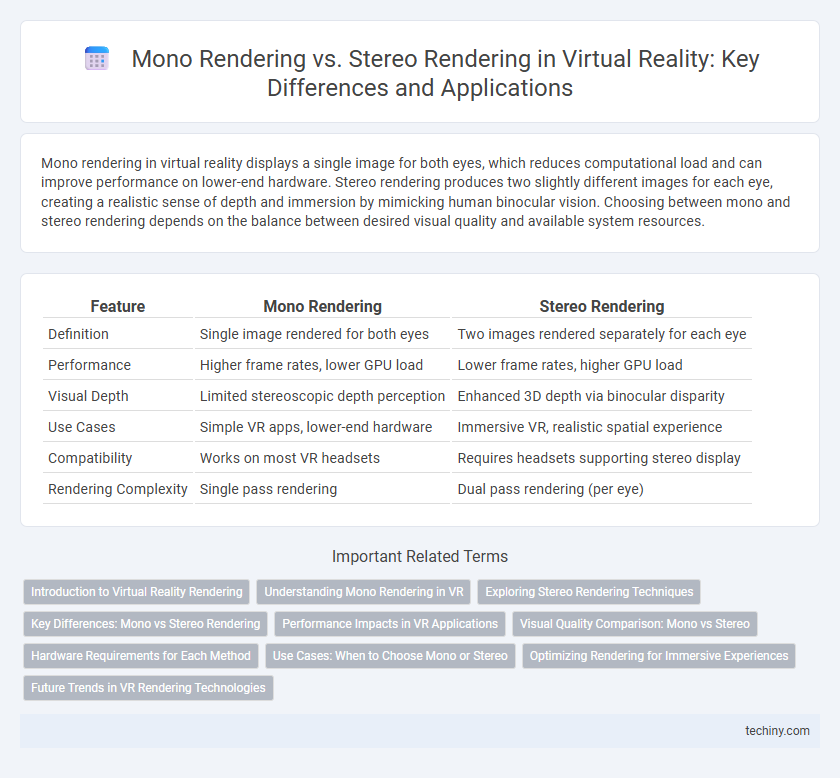Mono rendering in virtual reality displays a single image for both eyes, which reduces computational load and can improve performance on lower-end hardware. Stereo rendering produces two slightly different images for each eye, creating a realistic sense of depth and immersion by mimicking human binocular vision. Choosing between mono and stereo rendering depends on the balance between desired visual quality and available system resources.
Table of Comparison
| Feature | Mono Rendering | Stereo Rendering |
|---|---|---|
| Definition | Single image rendered for both eyes | Two images rendered separately for each eye |
| Performance | Higher frame rates, lower GPU load | Lower frame rates, higher GPU load |
| Visual Depth | Limited stereoscopic depth perception | Enhanced 3D depth via binocular disparity |
| Use Cases | Simple VR apps, lower-end hardware | Immersive VR, realistic spatial experience |
| Compatibility | Works on most VR headsets | Requires headsets supporting stereo display |
| Rendering Complexity | Single pass rendering | Dual pass rendering (per eye) |
Introduction to Virtual Reality Rendering
Mono rendering in virtual reality displays a single image to both eyes, reducing computational load and allowing for faster performance, ideal for less complex VR experiences. Stereo rendering generates two separate images from slightly different perspectives, mimicking human binocular vision, which enhances depth perception and immersion in VR environments. Understanding the trade-offs between mono and stereo rendering is crucial for optimizing VR applications based on hardware capabilities and user experience goals.
Understanding Mono Rendering in VR
Mono rendering in virtual reality involves generating a single 2D image that is displayed identically to both eyes, reducing computational load compared to stereo rendering. This technique is often used in applications where performance is critical, such as mobile VR or less graphically intensive experiences, as it simplifies the rendering pipeline by avoiding the need to produce two separate images for each eye. Understanding mono rendering highlights its trade-off between visual depth perception and system efficiency, making it suitable for specific VR scenarios that prioritize frame rate stability over immersive stereoscopic effects.
Exploring Stereo Rendering Techniques
Stereo rendering techniques in virtual reality create two slightly different images for each eye, enhancing depth perception and immersion by mimicking human binocular vision. Methods like multi-view rendering and foveated stereo rendering optimize performance by reducing redundant computations and focusing graphical details where the eye naturally converges. Advanced stereo rendering algorithms significantly improve VR experiences by balancing computational load and visual fidelity, essential for maintaining high frame rates and minimizing latency.
Key Differences: Mono vs Stereo Rendering
Mono rendering delivers a single image to both eyes, resulting in lower computational load and reduced GPU strain, making it suitable for simpler VR applications or devices with limited processing power. Stereo rendering generates two distinct images, one for each eye, to create a convincing 3D depth perception essential for immersive VR experiences but demands higher processing power and bandwidth. The key difference lies in depth perception quality and performance requirements, with stereo rendering providing enhanced realism at the cost of increased resource consumption compared to mono rendering.
Performance Impacts in VR Applications
Mono rendering processes a single image frame for both eyes, significantly reducing GPU load and enhancing frame rates in VR applications. Stereo rendering requires rendering separate images for each eye, doubling the workload and often causing increased latency and decreased performance. Optimizing VR applications through mono rendering can improve responsiveness and reduce motion sickness by maintaining higher and more stable frame rates.
Visual Quality Comparison: Mono vs Stereo
Mono rendering processes a single image stream, resulting in lower computational cost but reduced depth perception and immersion in virtual reality environments. Stereo rendering generates two distinct images, one for each eye, enhancing depth cues and providing a more realistic 3D visual experience. While stereo rendering demands higher GPU performance, it significantly improves visual quality by delivering accurate spatial representation and reducing eye strain in VR applications.
Hardware Requirements for Each Method
Mono rendering in virtual reality requires significantly less GPU power and memory bandwidth compared to stereo rendering, making it compatible with lower-end hardware setups. Stereo rendering demands dual rendering processes for each eye, effectively doubling the workload and necessitating high-performance GPUs and more VRAM to maintain smooth frame rates and high-resolution visuals. Efficient VR systems often employ techniques like single-pass stereo rendering to optimize hardware usage while delivering immersive stereo experiences.
Use Cases: When to Choose Mono or Stereo
Mono rendering is ideal for applications requiring lower computational power, such as mobile VR experiences or simple 360-degree videos, where the user views content without the need for depth perception. Stereo rendering is essential for immersive VR environments like gaming, training simulations, and architectural walkthroughs, where accurate depth cues enhance realism and user interaction. Selecting mono or stereo rendering depends on the balance between performance constraints and the necessity of a 3D stereoscopic experience.
Optimizing Rendering for Immersive Experiences
Mono rendering processes a single image frame for both eyes, reducing GPU load and enhancing performance in less complex VR environments. Stereo rendering generates two distinct images simultaneously, one for each eye, which increases visual realism and depth perception at the cost of higher computational demands. Optimizing immersive VR experiences requires balancing frame rates and latency, often utilizing techniques like foveated rendering and asynchronous reprojection to maintain smooth, high-fidelity visuals in stereo rendering scenarios.
Future Trends in VR Rendering Technologies
Future trends in VR rendering technologies emphasize the shift from traditional mono rendering to advanced stereo rendering techniques that deliver enhanced depth perception and immersive experiences. Innovations in foveated rendering and real-time ray tracing optimize performance while maintaining high visual fidelity, reducing latency and computational load. Emerging AI-driven rendering methods are expected to further revolutionize VR by dynamically adapting image quality based on user focus and hardware capabilities.
Mono Rendering vs Stereo Rendering Infographic

 techiny.com
techiny.com